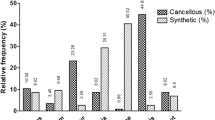Abstract
Bone grafting is used to enhance healing in osteotomies, arthrodesis, and multifragmentary fractures and to replace bony loss resulting from neoplasia or cysts. They are source of osteoprogenitor cells and induce bone formation and provide mechanical support for vascular and bone ingrowth. Autografts are used commonly but quantity of harvested bone is limit. This study was designed to evaluate fresh cortical autograft and allograft effects on bone healing process. Twenty male White New Zealand rabbits were used in this study. In autograft group the defect was filled by fresh autogenous cortical graft, in allograft group the defect was filled by a segment of fresh allogenous cortical bone which was harvested at the time of surgery during the creation of radius bone defect. Then all surface soft tissue, such as muscle attachments, were removed from the harvested bone and changed between rabbits as a fresh allogenous cortical bone graft and was fixed by cercelage wire. Radiological, histopathological and biomechanical evaluations were performed blindly and results scored and analyzed statistically. Statistical tests did not support significant differences between two groups at the 14th and 56th postoperative day radiographically (P > 0.05). There was a significant difference radiologically for the 28th and the 42nd postoperative (P < 0.05). Autograft was superior to allograft at the 28th and 42nd postoperative day in radiological evaluation (P < 0.03). Histopathological and biomechanical evaluation revealed no significant differences between two groups.






Similar content being viewed by others
References
Albrek T, Johansson C (2001) Osteoinduction, osteoconduction and osteointegration. Eur Spine J 10:S96–S101. doi:10.1007/s005860100282
Alexander JW (1985) In: Leonard’s orthopedic surgery of the dog and cat WB Sounders Company, Florida
Alexander JW (1987) Bone grafting. Vet Clin North Am Small Anim Pract 17:811–819
An YH, Friedman RJ (1999) Animal models in orthopedic research. CRC Press Inc., Boca Raton Florida
Bauer TW, Muschler GF (2000) Bone graft materials: an overview of the basic science. Clin Orthop Relat Res 371:10–27. doi:10.1097/00003086-200002000-00003
Bolander ME, Galian G (1983) The use of demineralize bone matrix in the repair of segmental defect. J Bone Jt Surg 68A:1264–1274
Brinker WO, Piermattei DL, Flo GL (1997) Bone grafting. Small animal orthopedics and fracture repair. WB Saunders Company, Florida, pp 147–153
Deijkers RLM, Bloem RM, Petit PLC, Brand R, Vehmeyer SBW, Veen MR (1997) Contamination of bone allografts. Analysis of incidence and predisposing factors. J Bone Joint Surg Br 79:161–166. doi:10.1302/0301-620X.79B1.7137
Dorea HC, McLaughlin RM, Cantwell HD, Read R, Armbrust L, Pool R, Roush JK, Boyle C (2005) Evaluation of healing feline femoral defects filled with cancellous autograft, cancellous allograft or bioglass. Vet Comp Orthop Traumatol 18:157–168
Enneking WF, Campanacci DA (2001) Retrieved human allografts-a clinicopathological study. J Bone Joint Surg Am 83:971–986
Erbe EM, Marx JG, Clineff TD, Bellincampi LD (2001) Potential of an ultraporous beta-tricalcium phosphate synthetic cancellous bone void filler and bone marrow aspirate composite graft. Eur Spine J 10:S141–S146. doi:10.1007/s005860100288
Fitch R, Kerwin S, Newman-Gage H, Sinibaldi KR (1997) Bone autografts and allografts in dogs. Comp Vet Cont Ed 19:558–575
Floyd T, Ohnmeiss D (2000) A metaanalysis of autograft versus allograft in anterior cervical fusion. Eur Spine J 9:398–403. doi:10.1007/s005860000160
Fox SM (1984) Cancellous bone grafting in the dog: an overview. J Am Anim Hosp Assoc 20:840–848
Friedlaender GE (1987) Bone grafts: the basic science rationale for clinical applications. J Bone Joint Surg Am 69:786–790
Goldberg VM, Stevenson S, Shaffer JW, Davy D, Klein L, Zika J et al (1990) Biological and physical properties of autogenous vascularized fibular grafts in dogs. J Bone Joint Surg Am 72:801–810
Gupta MC, Maitra S (2003) Bone grafts and bone morphogenetic proteins in spine fusion. Cell Tissue Bank 3:255–267. doi:10.1023/A:1024605128411
Heiple KG, Goldberg VM, Powell AE, Bos GD, Zika JM (1987) Biology of cancellous bone grafts. Orthop Clin North Am 18:179–185
Inoue K, Ohgushi H, Yoshikawa T, Okumura M, Sempuku T, Tamai S et al (1997) The effect of aging on bone formation in porous hydroxyapatite: Biochemical and histologic analysis. J Bone Miner Res 12:989–994. doi:10.1359/jbmr.1997.12.6.989
Keating JF, McQueen MM (2001) Substitutes for autologous bone graft in orthopaedic trauma. J Bone Joint Surg Am 83-B:3–8. doi:10.1302/0301-620X.83B1.11952
Kim DH, Jenis L, Berta SC, Vaccaro AR (2003) Bone graft alternatives in spinal fusion surgery. Curr Opin Orthop 14:127–137. doi:10.1097/00001433-200306000-00002
Lane JM, Sandhu HS (1987) Current approach to experimental bone grafting. Orthop Clin North Am 18:213–225
Lind M, Bunger C (2001) Factors stimulating bone formation. Eur Spine J 10(2):S102–S109
Lohmann CH, Andreacchio D, Koster G, Carnes DL, Dean BD, Schwartz Z (2001) Tissue response and osteoinduction of human bone grafts in vivo. Arch Orthop Trauma Surg 121:583–590. doi:10.1007/s004020100291
Marchesi DG (2000) Spinal fusion:bone and bone substitutes. Eur Spine J 9:372–378. doi:10.1007/s005860000203
McLaughlin RM, Roush JK (1998) Autogenous cancellous and cortico-cancellous bone grafting. Vet Med 93:1071–1074
Norman-Taylor FH, Villar RN (1997) Bone allograft: a cause for concern? J Bone Joint Surg Br 79:178–179. doi:10.1302/0301-620X.79B2.7492
Poitout DG (1996) Future of bone allografts in massive bone resection for tumors. Presse Med 30:527–530
Pokorny JJ, Davids H, Moneim M (2003) Vascularized bone graft for scaphoid nonunion. Tech Hand Up Extrem Surg 7:32–36. doi:10.1097/00130911-200303000-00007
Stryhal F, Matejovsky Z (1973) Indication of homotransplatation in hip arthroplasty. In: Chapchal G (ed) Arthroplasty of the hip. Thieme, Stuttgart, pp 56–61
Van Heest A, Swiontkowski M (1999) Bone-graft substitutes. Lancet 353:28–29
Wittenberg RH, Moeller J, Shea M, White AA, Hayes WC (1990) Compressive strength of autologous and allogenous bone grafts for thoracolumbar and cervical spine fusion. Spine 15:1073–1078. doi:10.1097/00007632-199015100-00017
Author information
Authors and Affiliations
Corresponding author
Rights and permissions
About this article
Cite this article
Shafiei, Z., Bigham, A.S., Dehghani, S.N. et al. Fresh cortical autograft versus fresh cortical allograft effects on experimental bone healing in rabbits: radiological, Histopathological and Biomechanical evaluation. Cell Tissue Bank 10, 19–26 (2009). https://doi.org/10.1007/s10561-008-9105-0
Received:
Accepted:
Published:
Issue Date:
DOI: https://doi.org/10.1007/s10561-008-9105-0




